Library of Congress's Blog, page 188
May 11, 2012
Nothing Could be Righter Than to Be a Reading Writer
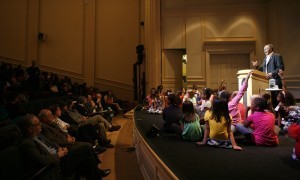
Walter Dean Myers interacts with kids at the Library
Take 550 grade- and middle-school kids; put ‘em in a room with an amazing author they know and love; add a barrage of questions about the creative process and a dash of humor.
One hour later, open the doors and stand back as a large flock of reading would-be writers burst out upon the world!
Today, Walter Dean Myers, in dialogue with just such a crowd of engaged kids from several District of Columbia-area elementary and middle schools, talked about how he became the award-winning author of more than 100 books – indeed, about how he became the Library of Congress National Ambassador for Young People’s Literature. In a talk at the Library’s Coolidge Auditorium, Myers told the entranced crowd that a story requires “an interesting character with an interesting problem.”
As he invited his audience to think of the times they’ve snapped out of a daydream to ask, “How did I get here,” he revealed elements of his own life that tabbed him as an interesting character who lived through a set of interesting problems.
First off, he was born Walter Milton Myers. But he became Walter Dean Myers after being brought up by foster parents named Dean, in Harlem.
His foster father couldn’t read, but his foster mother liked romance magazines, and as he followed her finger following the text as she read aloud, he began to put the words on the page together with what she was saying.
He became an avid reader of everything from his neighbor’s discarded comic books to “Robin Hood,” in which he visualized himself as the outsize character “Little John.”
But Myers had a couple of interesting problems: he dropped out of school at 15, preferring basketball and baseball to school. And he liked to read, but he lived in a neighborhood where that wasn’t considered cool – so he hid his library books in a big paper grocery sack to stay out of fights on the way home.
After a stint in the Army – and the death of his brother, who was also a soldier of the Vietnam War era – Myers began to write. He wrote about what he knew – basketball, Harlem, Vietnam. Some of it wasn’t good, but he developed a discipline about it and got better and better. And he started to make a living at it.
Every day, Myers said, he’ll wake up between 4:30 and 5 a.m., make some coffee and “feed my wife’s little ugly cat.” Then he’ll start writing – five pages a day, five days a week. “I write more than anybody in their right mind would publish, but I still love it,” he said.
“It’s a great life.”
Myers’ theme this year as National Ambassador is: “Reading is Not Optional.” In remarks he made when he was named to the post earlier this year, he noted that his great life was made possible by being a good reader – and that the jobs of today require an ability to read.
His talk today memorialized the late Jonah S. Eskin, an avid young reader whose family honors his memory by supporting an annual lecture at the Library by a major children’s author. His parents, Barney and Marcia, were there, along with his brother Lee, other family members and friends.
As the 550 kids burst out of the auditorium today – jazzed by Myers’ talk and eager to visit the Library’s Young Readers Center, participate in the D.C. Public Library’s summer reading program and a “Book That Shaped Me” essay contest the Library of Congress is locally sponsoring as part of the lead-up to its September National Book Festival – you could almost feel the heft of the books many of them will read, and write, in your empty hand.
May 10, 2012
Pics of the Week: Bacharach and David Honored with Gershwin Prize
The Library of Congress rolled out the red carpet on Tuesday to honor Burt Bacharach and Hal David with the 2012 Library of Congress
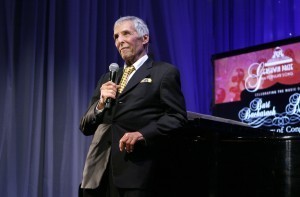
Burt Bacharach / Abby Brack
Gershwin Prize for Popular Song. The prize commemorates George and Ira Gershwin, the legendary American songwriting team whose extensive collection resides in the Library of Congress.
The all-star tribute concert featured performances by Sheryl Crow, Michael Feinstein, Diana Krall, Mike Myers, Lyle Lovett, Rumer, Sheléa, Arturo Sandoval and Stevie Wonder.
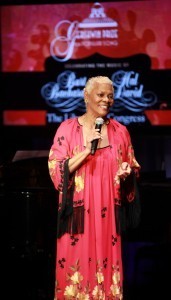
Dionne Warwick / Abby Brack
Dionne Warwick’s performance of “What the World Needs Now is Love” had the crowd singing along. In 1965, Bacharach and David wrote the song but shelved it as a flop. David was stuck on what should come after the line, “No, not just for some, but for everyone.” Then, one day, he thought of, “Lord, we don’t need another mountain,” and all at once knew how the lyric should be written. It had taken him two years to get it right. Bacharach immediately came back to the table with the backing music. Still, the duo was disenchanted and put the song away again. A day came when they were short of songs for a recording session. This one was pulled and the rest, as they say, is history.

Mike Myers / Abby Brack
Perhaps taking away best-dressed honors was actor Myers, who peeled off his suit to reveal a sparkly Elvis Presley-like jumpsuit. If you’re familiar with the comedian’s “Austin Powers” movies, you’ll recall that Bacharach had cameos in all three and much of his music was an inspiration for them.
An emotional Bacharach said, “This is the whole conglomeration of my work that I’ve done. So it’s the best of all awards possible. I mean that with all my heart.”
May 7, 2012
Children’s Crusade
(The following is a guest article about Walter Dean Myers, National Ambassador for Young People’s Literature, written by my colleague Mark Hartsell, which recently appeared in the Library’s staff newsletter, the Gazette.)
Something about his fan mail disturbs Walter Dean Myers.

Walter Dean Myers visits with students at 13th Avenue School in Newark, N.J., as part of the My Very Own Library literacy initiative, supported by the Foundation for Newark’s Future, the city of Newark and Ms. Anne Feely.
Myers, the author of critically acclaimed books for young people such as “Monster,” “Fallen Angel” and “Lockdown,” appreciates the gesture.
But in too many of the letters, evidence of a serious decline in the reading and writing skills among the youth of America is painfully obvious.
“It used to be that when you got fan mail, you could look at the letter and guess the age – oh, this is from a second grader, this is from a third grader,” Myers says. “Today, it could be from a high school kid, the writing is so bad and the spelling is so bad. There is a noticeable difference.”
Myers now has a new platform from which to address the issue, one he believes is critical – in January, he was inaugurated as the national ambassador for young people’s literature in a ceremony at the Library of Congress.
Myers returns to the Library on Friday, May 11 at 11 a.m. for a Children’s Book Week program in the Coolidge Auditorium, where he will read from his work and discuss the importance of literacy for young people.
The event, supported by the Jonah S. Eskin Memorial Fund, is free and open to the public. No tickets are required.
Myers used to get about two invitations a week from schools, libraries and other groups for appearances at literary events – a number that has increased to about six since he became ambassador.
Such programs, he says, can be “a bit frustrating”: Those who attend generally need no convincing of the importance of reading, and Myers especially wants to reach the audience most in need of help.
“Most of the programs are for people who read well,” he says. “I thought [as ambassador] I would emphasize people who read badly.”
With that in mind, Myers selected “reading is not optional” as the theme of his two-year ambassadorship – a theme that makes clear his belief in the necessity of reading to a prosperous life.
That, the 75-year-old Myers says, wasn’t as true when he was a kid.
Then, 15 families lived in his building in Harlem. One of the men worked for the postal service, and all the others worked in factory or service jobs.
“They didn’t have to read and write,” Myers says. “If you didn’t have the ability to read in those days, you could still make a living, you could still feed your family. Today, you can’t do that.”
As ambassador, Myers hopes to convince the young people most at risk of that.
“I’m more open to poorer schools,” he says. “I’m more open to kids who are further behind.”
His schedule illustrates his approach: Myers, naturally, includes visits to book festivals and libraries but also, for example, a visit to a juvenile detention center in Delaware, a Skype session with students at a school for children with learning disabilities in New Jersey and a visit to a detention center in Tennessee.
“Some of these kids are so far behind,” Myers says. “It’s very, very sad. What are they going to do? … “Are they going to be unemployed or underemployed all their lives because they don’t have the education to take meaningful jobs and they don’t have the education to change jobs?”
Part of the problem, he says, is people are reluctant to address the issue directly.
“We need to change the environment in an important way, and we need to have people with the guts to speak about it,” Myers says. “Right now as a society, we’re loath to speak about it because we don’t want to be viewed as blaming the poor. We don’t want to be viewed as being racist.
“The way to go is to confront the problem and change the atmosphere – begin to tell children and their families and communities that reading is not something that is going to be a pleasant adjunct to their lives, but it is going to be something that is fundamental to their existence.”
Myers learned that himself the hard way.
He was born in Martinsburg, W.Va., during the Great Depression. His mother died when he was very young. His father gave him to a Harlem couple, Herbert and Florence Dean, to raise.
Herbert Dean – who, Myers discovered only after his death, was illiterate – worked his entire adult life as a janitor. Florence Dean cleaned houses and worked in a button factory.
When Myers was 13, his uncle was murdered, his stepfather went into depression, and his stepmother became a “full-fledged alcoholic.”
Myers attended Stuyvesant High School – a school for smart kids – but couldn’t stay out of trouble. He suffered a speech impediment. He got into fights, skipped classes and, at 17, dropped out of school and joined the Army.
All along, he read – even though he couldn’t relate to classical literature. “Nothing in my life was in any of those books,” he says.
At 20, he read a short story in a literary quarterly by James Baldwin, who was raised about a half-mile from where Myers lived in Harlem.
The story was “Sonny’s Blues,” and it was set in Harlem – a revelation to Myers.
“I was just amazed that anybody was writing about Harlem,” he says.
Eventually, Myers began to write – first short fiction about sports and later about the most difficult period of his life, his teens.
“I never thought I’d make a living at writing, but it made me feel good about myself since I hadn’t finished high school,” he says.
Now, 58 years after he dropped out of high school, Myers is the acclaimed author of more than 100 books – stories for young people that explore serious and often bleak subjects.
“Fallen Angels” tells of a Harlem teenager who volunteers to serve in Vietnam after his dreams of attending college fail. “Dope Sick” chronicles the experiences of a 17-year-old with a drug habit. “Monster,” for which Myers won the Michael L. Printz Award in 2000, follows a 16-year-old in Harlem who is charged with murder.
“I want kids to say, my neighborhood is not that bad if Walter Dean Myers can write about it,” Myers says. “Let me read what he has to say.”
Myers first began visiting prisons many years ago – he wanted to understand the path from innocent third grader to criminal.
Those inmates, he figured, were too old to help. Maybe, though, he could use the insights gained during his youth to help a younger generation in juvenile detention centers.
“When I tell people that I was given away when I was 3 to some family friends, they recognize this,” Myers says. “They want to know how I felt at that time because they want to compare it to how they feel.”
That, he says, helps inspire what he writes – and what he chooses to do as the ambassador for young peoples literature.
“What I want to do for the two years that I’m the ambassador, I want to be useful,” he says. “How I can be useful is to take all the research on literacy and writing and make it into a public discussion. I want to change the discussion from the idea of reading as a pleasant and wonderful thing you can add to your life to reading as something that you absolutely have to have in your life.
“Reading is not optional.”
More information about the National Ambassador for Young People’s Literature is available here.
May 4, 2012
Library in the News: April Recap Edition
April seemed to be a picture-perfect month for the Library of Congress in the headlines. Its release of a rare collection of images by Frances Benjamin Johnston, one of the first female professional photographers, made it into several high-profile media outlets, including The Washington Post, The New York Times and the Associated Press.
“On one level, the collection is a valuable inventory of gardens at a time when landscape design rose with the nation’s wealth and cultural aspirations but then disappeared during the Great Depression,” wrote Post reporter Adrian Higgins. “For Johnston admirers, the images represent a true artist at work, one who would manipulate her pictures at every stage in pursuit of the perfect evocation of a given garden.”
In addition, the Library has continued to make strides in identifying images of the Civil War soldiers in its Liljenquist collection. Ramona Martinez of National Public Radio did a little investigating of her own in trying to find out about a Union soldier. Her discoveries sounded pretty convincing, until she hit a snag …
While maybe not known for photographs, Lee Strasberg certainly helped put people in pictures. The renowned acting instructor – father of the Method style – helped kick-start the careers of James Dean, Al Pacino and Marilyn Monroe, among others. The Library recently acquired his personal papers thank to a generous donation from his widow, Anna, and son, Adam. Picking up the announcement was Variety, Associated Press, The Examiner, The Washington Post and the Los Angeles Times.
Recently the Library marked Preservation Week with a series of events on how to care for and preserve precious mementos, including photographs and paper documents. In fact, the Library works hard to make sure its own collections are preserved and accessible for generations to come. Its Packard Campus for Audio-Visual Conservation is a hub of such activity. The Washington Post ran an article on the work it’s doing to safeguard our “obsolete technology” and pop culture.
“Maybe preservation is overrated, really, if what we’re preserving is the rise and fall of Susan Lucci’s hair, the never-ending ‘American Pie’ franchise, the extemporaneous Twitter feed,” wrote reporter Monica Hesse. “But then, our recent past it not any trashier than the pop culture of more distant pasts; the difference is that much of that trash ended up in the garbage. There is meaning in the gleaming blond of Ricky Schroder’s hair; we’re just not far enough away to understand it yet, and by the time we are, the tape will have disintegrated.”
April 27, 2012
Who Does Rob Think He Is?
Tonight at 8 p.m. EDT, NBC airs another episode of its popular “Who Do You Think You Are” series … this time starring actor Rob Lowe and the Library of Congress. You can catch a quick preview here.
Lowe ventures into his past and discovers an ancestor who battled against George Washington during the American Revolution.
While I can’t reveal all of the juicy details, I can tell you that Lowe spent a considerable amount of time in the Library’s Manuscript Division mining the Peter Force Collection of Americana, as well as working with our curators in the Local History and Genealogy Division.
“Who Do You Think You Are?” follows some of today’s most beloved and iconic celebrities as they embark on personal journeys of self-discovery to trace their family trees. In addition to Lowe, this season’s celebs include Martin Sheen, Marisa Tomei, Blair Underwood, Helen Hunt, Reba McEntire, Jerome Bettis, Rita Wilson, Edie Falco, Rashida Jones, Jason Sudeikis and Paula Deen.
April 26, 2012
Author as Superstar
(This post comes to us from Taru Spiegel, reference specialist in the European Division, which is cosponsoring the event along with the Poetry and Literature Center.)

Karl Ove Knausgård
What does a serious, award-winning author do when he is chosen “sexiest man of the year” by a leading women’s magazine? (He received the accolades from ELLE Norway in 2010.) According to various newspaper accounts, the Norwegian best-seller Karl Ove Knausgård said a few bad words.
Knausgård won instant critical praise for his earliest books in 1998 and 2004. He acquired major international fame with his six-volume memoirs “My Struggle,” published in Norway between 2009 and 2011. The autobiography has generated much public discussion concerning the ethics of Knausgård’s personal observations about friends and family members, including his alcoholic father and relations with his former wife. However, he is also mercilessly candid when it comes to himself.
Knausgård will appear at the Library of Congress on Wednesday, May 2, at 6:30 p.m. to discuss and sign book one of “My Struggle,” now available in English. The event will be held in Madison Hall, located on the first floor of the James Madison Building, 101 Independence Ave. S.E., Washington, DC. Reservations are required; contact (202) 707-5395 or poetry@loc.gov.
Oh, and by the way, after the first shock wore off, Knausgård treated his superstardom with a sense of humor – which he has in considerable amounts.
April 25, 2012
The Armenian Literary Tradition
Last Thursday, the Library of Congress opened its newest exhibition, “To Know Wisdom and Instruction: The Armenian Literary Tradition at the Library of Congress,” and I had a chance to take a tour with its curator, Levon Avdoyan, the Library’s Armenian and Georgian area specialist in the Near East Section of the African and Middle Eastern Division.
The exhibition marks the 500th anniversary of Armenian printing and UNESCO’s designation of Yerevan – the capital of the Republic of Armenia – as its Book Capital of the World, 2012.
The tri-colors of the Armenian flag provide the perfect motif to bring the display together in what Avdoyan describes as a series of “little stories about Armenian tradition.”
In 1512, Hakob Meghapart (Jacob the Sinner) opened an Armenian press in Venice, Italy, and published an Armenian religious book, “Urbatagirk” (the Book of Fridays). The era of Armenian printing had begun. While the Library does not own one of the few copies of the book, the more than 70 objects showcased aptly highlight the movement it sparked.
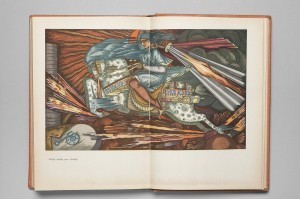
David of Sasun: The Armenian Folk Epic, second printing, illustrations by Hakob Kojoyan, Yerevan: Haypethrat, 1961. African and Middle Eastern Division.
While many of the items on display are religious in nature, the exhibition also presents secular elements as well. Manuscripts range from 14th- and 15th-century gospel books hand-copied by monks to 19th-century works on palmistry (Constantinople, 1894), fire-fighting (Venice, 1832), cotton production (Paris, 1859) and the first modern Armenian novel, “Armenia’s Wounds,” by K. Abovyan (1848). The first complete Armenian language printed Bible from Amsterdam in 1666 is on display, along with a richly illuminated missal copied in 1722 for the use of the celebrant of the Armenian liturgy and a rare 19th-century musical manuscript by Pietro Bianchini, who was the first to transcribe the Armenian liturgy using European musical notation. A 20th-century Soviet edition of the Armenian national epic, “David of Sasun” (1962) is also on display.
And an interesting note: one of the last items I viewed in the exhibition involved one of my favorite poets, Lord Byron, who apparently traveled to Armenia to learn the language. He wrote, “I found that my mind wanted something craggy to break upon; and this – as the most difficult thing I could discover here for an amusement – I have chosen to torture me into attention. It is a rich language, however, and would amply repay anyone the trouble of learning it.” On display, the noted romantic poet is depicted in a painting “The Mkhitarists Receive Byron on the Island of San Lazzaro,” by Armenian painter Hovhannes Ayvazovski, reprinted in a 2009 book by Shahen Khach’atryan.
“To Know Wisdom and Instruction” is on view through Sept. 26 in the South Gallery of the Thomas Jefferson Building from 8:30 a.m. to 4:30 p.m., Monday through Saturday. The exhibition is also available online.
Following the exhibition closing, all the exhibition items will be digitized and added to the World Digital Library, where information about each item will be made available in seven languages.
April 20, 2012
Pics of the Week: All the World’s a Stage
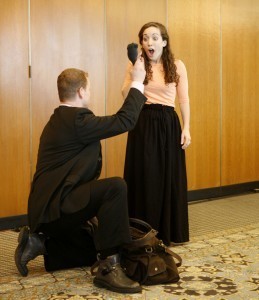
"Cymbeline" / Abby Brack
On Wednesday, the Library of Congress rung in William Shakespeare’s birthday with a celebration worthy of a standing ovation at the Globe Theater. Actors from the Shakespeare Theater Company’s Academy for Classical Acting at The George Washington University presented scenes from “Macbeth,” “Cymbeline,” “The Tempest,” Richard III” and “Julius Caesar.” (My own 10th grade recitation of Marc Anthony’s “Friends, Romans, Countrymen” speech – which I can still do to some degree – probably would have been more worthy of a thrown rotten tomato.)
This annual celebration is one of the highlights of the Library’s literary year and always attracts a large crowd.

"The Tempest" / Abby Brack
The Bard’s birthday is actually observed on April 23, but it’s not really known if that date is accurate. What is known is that William was baptized on April 26, 1564, at Holy Trinity Church in Stratford-upon-Avon. Religious custom at the time required a child to be baptized on the nearest Sunday or other holy day following the birth, unless there was a legitimate reason not to. April 23 was actually a Sunday, with the feast day of St. Mark the Evangelist following on the 25th. However, scholars have noted that St. Mark’s Day was considered unlucky, and superstition may have stopped the Shakespeares from baptizing their son at that time. Also, the Bard died on April 23, 1616, making for a rather attractive symmetry for biographers.
April 19, 2012
Down to Earth
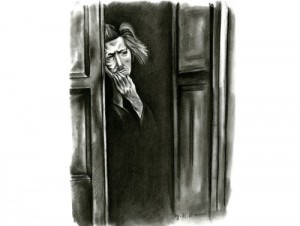
"Nothing can be Wealthier than Saving the Humanity," by Rohullah Hassani, 16, Quetta, Pakistan
Every year, Earth Day is celebrated on April 22 and citizens are called upon to do their part in protecting the environment, to promote and participate in “green living” and to celebrate our natural resources.
Conducted in affiliation with the Library of Congress Center for the Book and the Center for Environmental Literacy at Saint Mary’s College of California, the annual River of Words contest – which celebrates both National Poetry Month and Earth Day – is the largest youth poetry and art competition in the world, recognizing educational leadership in environmental literacy. Ten remarkable young poets and artists – ranging in age from 7 to 16 – and more than a dozen national finalists will be honored at the 17th annual awards on Monday, April 23, at 7 p.m. in the Library’s Montpelier Room.
Co-founded by former U.S. Poet Laureate Robert Hass and Pamela Michael, who now directs the Center for Environmental Literacy at Saint Mary’s, the goal of the contest is to “help children fall in love with the earth.”
Category I (Kindergarten – second grade) Grand Prize winner Blakely Berryhill, 7, from Vestavia Hills, Ala., writes in her poem, “The Guards”:
The sun guards the daytime treasure,
while the moon stands watch
over heaven’s darkness.
The stars help the moon
until the puffy white
clouds come back.
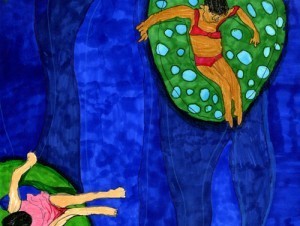
"Relaxing on Water," by Kristina Yu, 6, Suwanee, Ga.
11-year-old Julia Dixon of Washington, D.C., winner of the Anacostia Watershed Prize, laments urban sprawl in her poem, “A Birdseye View”:
As we feast upon dying species
And blame sharks for it all
The taxes we pay
Going into nuclear plants
Instead of schools
The artwork and poems of all the winners are available for viewing and reading at the River of Words website. May they inspire you to “Mobilize the Earth.”
April 17, 2012
This is Maverick Requesting a Fly By
Today marked a rather monumental occasion as the space shuttle Discovery made its final flight – not to the stars but to its permanent home at the Smithsonian’s National Air and Space Museum annex near Dulles, Va.
Library of Congress staff members were able to capture its final spin, as it took a few turns around the Capitol complex, including coming very close to the Library’s Thomas Jefferson Building dome. You can see the video here, with Discovery perched atop a Boeing 747 jet.
Discovery is the most traveled spaceship, leading the fleet with 39 missions. It is also the first of the three retired shuttles to go on display at a museum. Sister ships Endeavour and Atlantis go on display at the California Science Center in Los Angeles and the Kennedy Space Center Visitor Complex in Florida, respectively, later this year.
Library of Congress's Blog
- Library of Congress's profile
- 74 followers



